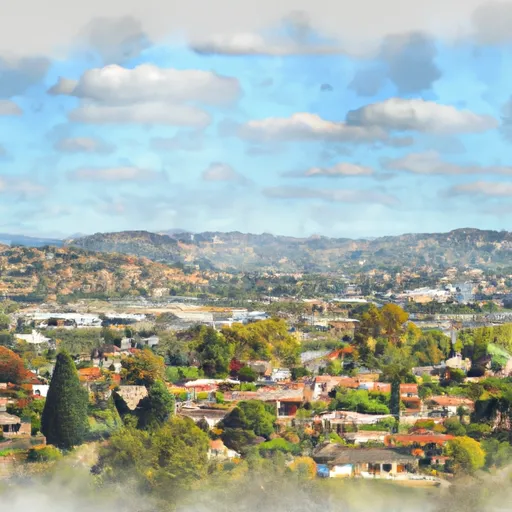-
 Snoflo Premium
Snoflo Premium
Get unlimited access to all our content
With no Ad interruptions! - Start Your Free Trial Login with existing account
Poway
Eden Index
Climate
9.0
•
Recreation
5.9
•
Community
5.6
•
Safeguard
7.1/10

Poway is a city located in San Diego County, California. The climate in Poway is characterized by warm, dry summers and mild winters. Summers can reach average temperatures of around 85°F (29°C), while winters average around 65°F (18°C). The city experiences low levels of precipitation, with most rainfall occurring between November and March.
Hydrologically, Poway is surrounded by rolling hills and is part of the San Diego River watershed. The main water source for the city is the Poway Municipal Water District, which draws water from the Colorado River and local reservoirs.
Outdoor recreation opportunities abound in Poway. The city is home to numerous parks and trails, making it ideal for hiking, biking, and picnicking. Lake Poway offers fishing, boating, and kayaking opportunities, while Blue Sky Ecological Reserve provides a chance to explore diverse plant and animal life. Poway also offers golf courses, equestrian trails, and a wide range of sports facilities.
Overall, Poway's pleasant climate, water resources, and abundance of outdoor activities make it an attractive destination for nature enthusiasts and outdoor lovers.
What is the Eden Index?
The Snoflo Eden Index serves as a comprehensive rating system for regions, evaluating their desirability through a holistic assessment of climate health, outdoor recreation opportunities, and natural disaster risk, acknowledging the profound impact of these factors on livability and well-being.
Climate Health Indicator (CHI): 9.0
Poway receives approximately
376mm of rain per year,
with humidity levels near 74%
and air temperatures averaging around
18°C.
Poway has a plant hardyness factor of
9, meaning
plants and agriculture in this region tend to thrive here all year round.
By considering the ideal temperature range, reliable water supplies, clean air, and stable seasonal rain or snowpacks, the Climate Health Indicator (CHI) underscores the significance of a healthy climate as the foundation for quality living.
A healthy climate is paramount for ensuring a high quality of life and livability in a region, fostering both physical well-being and environmental harmony. This can be characterized by ideal temperatures, reliable access to water supplies, clean air, and consistent seasonal rain or snowpacks.
Weather Forecast
Streamflow Conditions
Laguna-San Diego Coastal
Area Rivers
Laguna-San Diego Coastal
Snowpack Depths
Laguna-San Diego Coastal
Reservoir Storage Capacity
Laguna-San Diego Coastal
Groundwater Levels
Recreational Opportunity Index (ROI): 5.9
The Recreational Opportunity Index (ROI) recognizes the value of outdoor recreational options, such as parks, hiking trails, camping sites, and fishing spots, while acknowledging that climate plays a pivotal role in ensuring the comfort and consistency of these experiences.
Access to outdoor recreational opportunities, encompassing activities such as parks, hiking, camping, and fishing, is crucial for overall well-being, and the climate plays a pivotal role in enabling and enhancing these experiences, ensuring that individuals can engage in nature-based activities comfortably and consistently.
Camping Areas
| Campground | Campsites | Reservations | Toilets | Showers | Elevation |
|---|---|---|---|---|---|
| Dixon Lake | 45 | 1,062 ft | |||
| Kumeyaay Lake Campground - Mission Trails Park | 46 | 626 ft | |||
| Admiral Baker Military - San Diego NS | None | 79 ft | |||
| Dos Picos | 68 | 1,505 ft | |||
| Lake Jennings | None | 706 ft | |||
| Sweetwater Summit | 112 | 280 ft | |||
| Observatory | 37 | 4,857 ft | |||
| Santee Lakes Regional Park | 300 | 323 ft | |||
| Fiddlers Cove RV Military - Coronado NB | None | 8 ft | |||
| Silver Strand State Beach Dispersed | 140 | 12 ft |
Catastrophe Safeguard Index (CSI):
The Catastrophe Safeguard Index (CSI) recognizes that natural disaster risk, encompassing floods, fires, hurricanes, and tornadoes, can drastically affect safety and the overall appeal of an area.
The level of natural disaster risk in a region significantly affects safety and the overall livability, with climate change amplifying these risks by potentially increasing the frequency and intensity of events like floods, fires, hurricanes, and tornadoes, thereby posing substantial challenges to community resilience and well-being.
Community Resilience Indicator (CRI): 5.6
The Community Resilience Indicator (CRI) recognizes that education, healthcare, and socioeconomics are crucial to the well-being of a region. The CRI acknowledges the profound impact of these elements on residents' overall quality of life. By evaluating educational resources, healthcare accessibility, and economic inclusivity, the index captures the essential aspects that contribute to a thriving community, fostering resident satisfaction, equity, and social cohesion.

